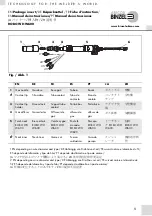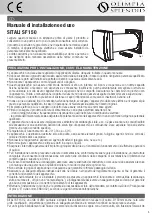
- 3 -
♦
Employment of a 16 cm woofer featuring a
newly developed HP diaphragm has made it a
reality to reproduce low distortion and highly
transient sound which used to be only a dream
with conventional diaphragms.
♦
Anti-resonance of diaphragm edges has been
successfully eliminated. The newly developed
UDR tangential diaphragm edge and push-pull
damper used in the woofer provide a breakthrough
in linearity and responsiveness to subtle signals.
♦
Highly rigid die-cast aluminum frames
engineered to eliminate sound colorization often
occurring due to undesirable natural resonances
are used on the woofer and tweeter.
♦
Tweeters, comprising a newly developed UFLC
diaphragm (soft dome) offering excellent response
and reproduction performance, are capable of
handling a wide frequency coverage of up to 40
kHz.
♦
The network used is of an exceptionally low
loss 6 dB crossover design which ensures
extremely natural transition between the woofer
and tweeter.
♦
The time-aligned enclosure has a baffle shaped
to keep it free of natural resonances caused by
diffracted reflection sounds.
♦
The use of an HP diaphragm and dome tweeter
has widened the listening area, which was not
possible with previous technology.
♦
An ideal internal processing method of natural
resonances developed by reflected sounds within
enclosures is now an actuality by removing such
natural resonances by an HP sound reflector.
♦
Terminals for bi-amplification systems are
provided for convenience in meeting studio-
specific environmental requirements.
♦
Employment of minimal magnetic leakage
design on both woofers and tweeters makes
placement of the system in close proximity to
monitors viable.
FEATURES
THE "SHOULD BE" OF MONITOR
Before undertaking development of NF-1, we recognized
anew the following 5 points as mandatory requirements
near-field monitors should satisfy.
1)To elevate the ability to analyze and check
original sounds and to reproduce said original
sounds to an absolutely optimal level.
2)To express to the fullest extent all the musical
nuances intended by the musicians and
engineers.
3)To provide engineers with a highly efficient
work environment where they can work,
unconscious of the existence and intervention of
sound reproduction speakers, free of stress and
fatigue caused by the necessity of corrections of
properties inherent to conventional speakers.
4)To be with horizontal directivity wide enough
to ensure minimal changes in timbre and sound
field regardless of engineers' horizontal
position. Vertical directivity, on the other hand,
is better to be narrow to enable circumvention of
reflection from mixing consoles.
5)To meet trends in recording studios of using
small yet high performance speakers. In recent
years, cases abound where small speakers are
used in the near field.
NF-1 has been developed to incorporate the following
elements as the engineering development themes
necessary not to miss any of these 5 points.
REQUIREMENTS OF SPEAKER DRIVERS
Reproduction frequency range to be the widest
possible (60Hz to 40kHz)
Fast response perceptible in the original sound to be
retained
Sufficient resolution to allow for desired signals and
noise present in floods of information to be
discernible
Localization of individual sound images to be
excellent
High input and output capability without altering
sound quality
Driver diameters to be as small as feasible, as dictated
by the idea that a point sound source is an ideal sound
source, and systems to be no more than 2-way
No specific sound to develop from any of diaphragm
materials, shape or structure
Good directivity
REQUIREMENTS OF SPEAKER ENCLOSURES
FEATURES
THE "SHOULD BE" OF MONITOR
a.
b.
c.
d.
e.
f.
g.
h.
Size to be small enough to provide convenience in
securely locating systems on mixing consoles to
ensure optimal proximity to the listening point
Time alignment to be impeccable within the listening
area
Natural resonance sounds not to be generated from
enclosures
To provide rich and deep sound to give listeners the
sensation of presence of a natural sound field
(Listeners are not to perceive that the sound source is
speakers in an enclosure.)
a.
b.
c.
d.


































